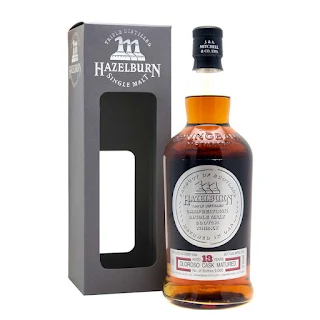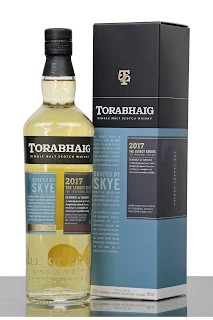7 october 2021.
A bit of history (those who are familiar with it can skip this part)
At the very beginning of the 19th century, brothers Donald and Alexander Johnston bought a piece of land on Islay, 1000 acres by the sea, to raise cattle. The place was called Laphroaig, which roughly translates as 'the cave by the bay'. As they had too much barley to feed the cows, they came up with the idea of producing whisky. The whisky proved to be good, and since whisky-making had only recently become legal, they killed their animals and officially opened their distillery in 1815.
Then Alexander emigrated to Australia and Donald died by drowning in a whisky barrel. Nevertheless, his cousin took over the business, and his son, Dugald Johnston, helped by Walter Graham, one of Lagavulin's directors, made the business prosper by including Laphroaig in the blends in vogue at the time, particularly those of Mackie and Co, the owners of Lagavulin.
Dugald died in 1877, followed by his brother-in-law in 1907, but the distillery remained in the family thanks to Ian Hunter, one of the brother-in-law's nephews. He broke the contract with Mackie and Co. in order to be able to produce single malt again, but this resulted in two painful court cases, which Ian Hunter won, although the distillery was in a bad way. Ian Hunter still managed to double whisky production, and during Prohibition, he sold his stock in pharmacies in the USA as medicine. No one says whether a prescription was needed, but it helped Laphroaig return to success.
When Ian Hunter died in 1954, he left the distillery in the hands of his secretary, Bessie Williamson. When she retired in 1972, the distillery passed into the hands of a large group, the Schenley Corporation. Then came Whitbread, followed by Allied Lyons in 1989.
But when Whitbread sold the distillery, they imposed Iain Henderson as Distillery Manager. He became a true legend, increasing annual sales by a factor of 8, receiving the Royal Warrant for the distillery, and founding the Friends of Laphroaig committee.
John Campbell succeeded him in 2006, before retiring next month. In the meantime, the distillery was sold to Beam Suntory in 2011, ensuring on the one hand an extremely solid infrastructure, and on the other the end of any traces of craftsmanship.
Laphroaig's Wash Spirit Stills
The Line Up Project
Laphroaig has so many different expressions that it is impossible to discover it in a single Line Up. What's more, I've been wondering for some time about the true identity of this distillery, which is one of my favourites. Over the last few years, since it was bought by Beam Suntory, the distillery has been evolving. New bottlings come one after the other, to the delight of some and the anger of others. What really got me going was a comment on Whiskybase from someone who said he only liked Laphroaig aged in Bourbon casks. However, over the last ten years or so, there has been a lot of ageing and/or finishing in Sherry casks or other wines. So my question is: where is Laphroaig heading? Is it really adapted to Sherry casks, or does it lose something that gives it its very special identity? In short, it was an opportunity to embark on a new Line Up, but needless to say, gathering the whiskies needed to answer these questions was an arduous task.
However, I think I've found all the distillery's wine bottlings, except for Port Wood, which I've heard is very similar to Brodir, which I have. So I think I've got a pretty comprehensive set.
The Tasting
Laphroaig Triple Wood : Launched in 2009, this one brought Sherry into the distillery. But be warned: this is a finish, not a full maturation. The nose in fuel oil, gas oil and motor oil. It's fair to say that the distillery's hallmarks are not lost with this one. The Sherry is in the background, adding body and a little fruitiness. Coal, rock. A good pile of peat on the palate, drain oil, strawberry and lemon, spices. Earthy finish, coffee and gravel, quite long. Score: 87
Laphroaig PX Cask : The PX Cask followed the Triple Wood in 2012. This is also a finish, and is sold in Travel Retail. Almost exactly the same nose as the previous one, just a little more diesel. The Sherry influence comes later, on fig paste and a hint of raspberry. The peat is heady, very heavy. On the palate, the genoise goes very well with the charcoal. Quite strong spices. Gas oil. Liquorish. Long, deep finish, maritime, rocky sandstone, lignite. Very long, warm. Score: 88Laphroaig 10 yo Sherry Oak Finish : It was released this year, and was so successful that it sold out in a matter of days. It was supposed to be part of the Core Range, but it turned out to be a limited edition. Despite its title, this is not only a finish, but also an Oloroso full cask-aged version. A lovely coaly Sherry. On red fruits, but also chocolate cake. Coal, gas oil and the rest comes later. More discreet than the previous two. Fine peat. Elegant. Mineral. Very pleasant, fruity palate, which sinks into a peaty slush. Spicy. Well-balanced. Long, earthy finish, cola, coffee, acetone. Score: 88Laphroaig Brodir : This one dates from 2014. There have been several Batches, I assume this is the last one. It was replaced by the Port Wood, whose notable difference from its predecessor is the much more expensive price. Once again, this is a finish. More on the thick smoke, the pungent charcoal. Very quickly, the port becomes heady and syrupy. A very fine marriage with lignite, peat and granite. Iodine. Well-refined petroleum. Candied cherries, blueberries, cough syrup. Quite spicy, charred and peaty on the palate. Nice finish, on fermented fruits, grapes, damsons, wood, charcoal. Score: 88
Laphroaig Càirdeas Port & Wine Casks : Every year since 2008, on the occasion of Feis Ile, the distillery has offered a Càirdeas bottling with a different profile each time. I've tasted several of them, but not all of them were a success. I've selected the latest two, including this one, released in 2020, aged in port casks and finished in red wine casks.
The nose is fairly sweet, with hints of pear compote and walnuts. The Laphroaig profile then takes over, with iodine, tin, steel and gravel. Plums and spices, it must be the Port. Fine and grimy smoke. A tiny medicinal touch. On the palate, mirabelle plums, greengages, oil and, of course, peat. Explosive, powerful, charred finish. Score: 88
Secret Islay 2007 The Nectar 15 Years : This nice 14-year-old was released this summer to celebrate the 15th anniversary of Daily Dram, the Belgian independent bottler. Everyone says it's Laphroaig. It's aged in a Monbazillac cask. Lots of fruits, juicy white plum, pear, even pineapple. Then comes the smoke, the gravel, the metal, the rock. Icing sugar, lemon zest. The fruits return with the addition of water, but also the smoke. On the palate, juicy peat, olive oil, mirabelles. Explosive finish, very long and warm, fruity, slightly acidic. Maracuja. Score: 91
Elements of Islay Lp9 : This is undoubtedly the pinnacle of what the combination of Laphroaig and Sherry can offer. Bottled in 1998, Single Cask, 20 years old, it could hardly be better. The PX cask comes to the fore, with damsons and blueberries, but the background is full of charcoal, earthy and deep. Pudding, muscat grapes, candied cherries, dried bananas. Very syrupy on the palate, woody, fig, fermented fruits. Behind, peat and petroleum. Beautiful finish, violent, never-ending, arable earth, minerals, coffee, dark chocolate, liquorice. Score: 91
A winey flavour, but more on the acidity than on the grapes. Heather earth, asphalt, nails, but that remains in the background. Clafoutis, plums, yellow apples. Slightly peaty on the palate, dried apricot, almond, pleasant, fairly long finish. Score: 90
Laphroaig Càirdeas Pedro Ximénez Casks : Finally, the latest Càirdeas, which was also a great success. This is officially a cask strength version of the PX Cask, but it seems to me that there are a few differences. Quite a heavy charcoal peat, enhanced by the influence of the PX casks. Oil, fuel oil and other things. But also red fruits. Thick, bewitching smoke. Oily on the palate, drain oil, gas oil, diesel. Blackcurrants, blueberries, Smyrna grapes. Explosive, fairly long finish, lignite, black earth, crushed raspberries. Score: 89
Tasting in the distillery
What I gain from it
- First of all, when it comes to simple Sherry finishes with prior ageing in Bourbon casks, Laphroaig loses none of its character. Triple Wood, PX Cask and Brodir are all very good bottlings. They have all the hallmarks of Laphroaig: charcoal, fuel oil, tyres, a medicinal touch and a coffee finish. So there's nothing to complain about, except that Triple Wood and Brodir are no longer produced today, and PX Cask is getting old.
- On the other hand, it has to be said that expressions aged in Sherry casks or other wine casks, even partially, come out impoverished of everything that makes up the Laphroaig galaxy. The charcoal comes out stronger and perhaps masks the rest. I didn't feel the medicinal touch, and less the motor oil aspect. In this sense, the 10 yo Sherry Oak Finish is particularly revealing of a new direction for the distillery, smoother and less ferrous. The last two Càirdeas are also part of this new direction. They are quite successful, by the way, but that's not the problem. I'd even go so far as to say that 10 Yo Sherry Oak Finish is my bedside whisky at the moment, as it's the one that goes down the fastest.
- The loss of the medicinal touch may be particularly regrettable, but on the other hand, the independent bottlings I have selected show that the quality of the distillate has not diminished at all, perhaps quite the contrary. The Oloroso, and even the PX, enrich the distillery's profile and extend its horizons.
In conclusion, we may well regret it, but we have to recognise that Laphroaig is now at a turning point in its evolution. Every distillery evolves over time, it's a fact of life. The takeover by Beam Suntory 10 years ago, and now John Campbell's retirement, are stages from which we cannot emerge unscathed.
However, I understand that there are fears. Laphroaig is without doubt the most divisive distillery in Scotland, the most original. If it loses a little of its originality, a little of Scotland goes with it.
But given the overwhelming success of recent editions, it's clear that Laphroaig will continue in the same vein. Will they be abandoning the Bourbon cask maturations that are the basis of their production? Not very likely.
See you in another Line Up to find out whether Bourbon cask ageing is also evolving. If so, there would be every reason to panic!





















